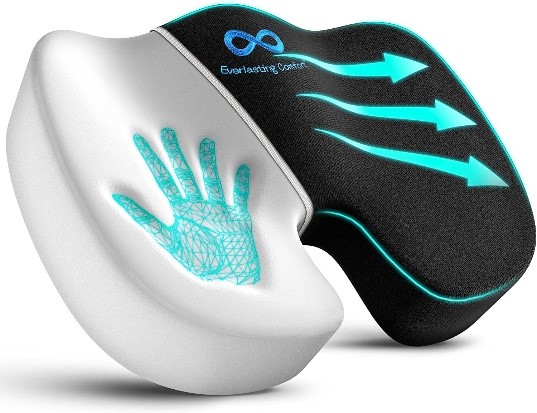Sciatica Pain Relief Cushion Reviews
Sciatica pain can make any normal activity turn into an excruciating task. Something as simple as sitting at your desk or driving your car can fill you with dread if you are suffering from sciatic pain. Even someone who looks perfectly healthy can experience sciatica, and it can be difficult for others to understand just how intense this discomfort can be. If you have experienced sciatic pain, either temporarily or long-term, you certainly understand the desperation patients have to find relief.

Thankfully, in addition to therapeutic exercises or medication physicians may offer to provide relief, there are also cushions designed to minimize the impact of this dreadful pain. We have rounded up three of our favorites here:
Before we take a closer look at each of these recommended cushions, we will first review what sciatica is and what causes it, and how cushions provide relief.
What is Sciatica?
Sciatica is the name given to pain caused by the sciatic nerve when it is irritated, inflamed, or compressed. The sciatic nerve is the largest in the human body, starting at your lower spine and ending in the sole of your foot.
When you think about the length and size of that nerve, you begin to get a good idea of just how much pain can be caused when it is impacted negatively by irritation or compression. Sciatica can cause pain starting in the buttocks region that travels down the leg.
Some patients describe sciatica as a nagging, burning, or shooting pain, but in addition to the pain, it can also be characterized by numbness. Sciatica pain usually occurs on one side only (though both legs may experience it simultaneously) and in many cases, patients feel worse when lying down or sitting.

Source: Pexels
This is one of the particularly challenging components of managing sciatica. When we think of pain in our lower back and legs we often think of “rest” as the key to recovery. However, the simple act of resting can be excruciating for some people with sciatica (hence the need for support from gel cushions).

Source: Shutterstock
Lower back problems such as a herniated lumbar disc or degenerative disc disease are usually the root cause of sciatica. It is important to note that not all leg and lower back pain is sciatica. You should always consult your physician if you have pain in your back, pelvis, legs, or other areas that is lingering and preventing you from going about your daily activities with ease.
How Can Cushions Help Manage Sciatica?
Sciatica sufferers are often desperate to find relief from this pain, which can have a detrimental effect on their quality of life. Most people with sciatica would sit on every pillow in their homes if they thought it meant the pain would go away.
Unfortunately, throwing your favorite but worn bed pillow under your bottom is not the key to managing sciatica. You need a specially designed cushion for this purpose, like the ones we will be reviewing below.
Simply put, cushions reduce the pressure on nerves, which in turn eases pain. In addition to the reduced pressure, these types of cushions can also help you improve your posture, which is important for preventing back pain. Cushions can also ease muscle tension, and for these reasons, you may find it wise to invest in one not only for sciatica but for the overall health of your spine, especially if you work long hours at a desk (or spend many hours driving).

Source: Pexels
Types of Cushions Used to Manage Sciatica Pain
Lower back and leg pain are so common that there are a wide variety of products available intended to help ease and manage symptoms, and this is certainly true when it comes to cushions and pillows. It can be overwhelming to know where to start when shopping, so we will give you a quick rundown of the types of cushions you will see before we highlight our three favorite products.
Memory Foam Cushions
Most people are familiar with memory foam thanks to its popularity in the mattress market, and it can also be seen in a wide variety of other products such as kitchen mats or even slippers.
Generally, memory foam cushions provide comfort, but some may feel too hard. They mold to and compress to your body, which may not provide relief from sciatica. (Always read user reviews for memory foam cushions to see if other customers have been satisfied when using them to address sciatica!)
Pressure Relief Ring Cushions
A donut-shaped pressure relief cushion can help prevent pain associated with sitting for long periods and help with weight distribution, but it may not be effective in addressing the sciatic nerve specifically. These are typically used to provide relief for hemorrhoids.
Gel Cushions
Gel cushions tend to be our favorite when it comes to addressing sciatic pain while sitting or driving. Typically, they are lightweight enough to be portable but durable enough to provide the appropriate amount of support and comfort.
Some cushions are also designed to alleviate the pain from pressure sores, especially for those with limited mobility. For example, a person recovering from surgery who spends hours a day in a recliner chair, or a senior who is unable to walk, could end up with painful sores from sitting in the same position for too long. Cushions can address this specific type of pain.
Sciatica Pain Relief Cushions: Our Top Three
1. ComfiLife Gel Enhanced Seat Cushion

- Material: Memory Foam + Cooling Gel Layer
- Dimensions: 17.6 by 13.8 by 2.75 inches
- Weight: 658 grams
Designed for placement in an office chair or a car seat, the ComfiLife Gel Enhanced Seat Cushion is a favorite among users for relief from sciatica pain. The U-shaped design and memory foam provide support to reduce lower back pain and tailbone pain and also reduce the pressure on the sciatic nerve.
There’s a lot to love about this durable and lightweight cushion. The zippered cover slips off easily so you can toss it in the washing machine, which will keep it looking (and smelling) fresh after many days of use. Speaking of the cover, you can choose between black, gray, and navy covers. We recommend black or navy as the gray will show stains more easily.
The non-slip bottom keeps the cushion in place, ensuring you do not slide around in your office chair or find yourself constantly having to adjust the pillow below you. That said, you might have to spend some time adjusting your body to find the perfect placement on the cushion and the position that offers you the most relief.
One important note about positioning is the fact that the U-shaped cut faces toward the back of your chair. The curve design of the cushion hugs the curves of your body, providing support where needed and also (thanks to the gel layer) cooling relief.
The ComfiLife Gel Enhanced Seat Cushion offers great value for the price and with a 60-Day Money Back Guarantee, this is a no-brainer choice if you are suffering from sciatica or any lower back and leg pain. You can also register the product with the manufacturer for a Lifetime Replacement Warranty.
2. Everlasting Comfort Seat Cushion Pillow

- Material: Premium Memory Foam
- Dimensions: 17 by 14 by 2 inches
- Weight: 680 grams
A versatile cushion that can be used everywhere from your car to your gaming chair, the Everlasting Comfort Seat Cushion Pillow with premium memory foam will always retain its shape, rebounding to its original form after each use.
This pillow provides the kind of comfort and support so desperately needed by those who suffer from sciatica, and it adapts to your curves and helps improve your posture while seated in addition to alleviating pain.
This lightweight cushion is perfect for everyday office use, and you can easily take it with you on the go if you want to use it in your vehicle, at the office, or at home. The nonslip rubber bottom keeps the cushion secure and prevents it from sliding around underneath you, and the breathable cover ensures you are not trapping heat in the cushion, making it a cool and comfortable place to sit.
The coccyx (or tailbone) cutout is designed to relieve pressure from your lower body, and this cushion is great for anyone with lower back pain from an injury, surgery, sciatica, or other cause. We love that the cover is machine washable, and we have seen a remarkable reduction in sciatica pain after using this cushion for even just days or weeks.
This cushion is also verified by Made in Green by Oeko-Tex, meaning it is manufactured with a reduced impact on the environment under socially responsible working conditions. A Lifetime Replacement Policy is also offered by Everlasting Comfort, and we encourage you to check out all of their other great products such as leg bolster pillows and knee pillows, which could help with sciatic nerve pain as you sleep.
3. STUFFED Gel Seat Cushion

- Material: Memory Foam and Gel
- Dimensions: 17.5 by 13.5 by 3 inches
- Weight: Three Pounds
Our last-but-not-least pick is another U-shaped cutout cushion that makes use of both memory foam and gel to provide relief from sciatica pain. This cushion from Stuffed is perfect for home or office and is recommended for adults from 150 to 300 pounds.
Whether you are working long hours toward a deadline, recovering from a surgery, or just gaming into the wee hours, this cushion can help with the pain associated with sitting for long periods.
The firmness of the foam (two layers) and the softness of the gel (one layer) work together to create the perfect balance of support and comfort, and the pillow’s design is intended to relieve pressure on the tailbone. The zippered cover can be removed, and machine washed in cold water, and the non-slip grip bottom keeps the cushion in place.
If you find pain radiating through your legs and lower back as you sit, this cushion could make a tremendous difference for you. We found it to be one of the best at reducing sciatica pain and also improving posture.
Other Ways to Manage Pain from Sciatica
Before you begin any type of treatment, be sure your physician has confirmed that the pain you are experiencing is indeed related to the sciatic nerve. You should always consult your healthcare provider about any ongoing pain you are experiencing and the best way to treat it.
In addition to using a special gel and/or memory foam cushion at home and work, some other things can be done to relieve the symptoms of sciatica.
While some serious cases may require surgery, it is advised to try a variety of nonsurgical treatments first, including:
- Physical therapy
- Medication (OTC pain relievers or some prescription-strength medications)
- Therapeutic injections
Physical therapy exercises can provide tremendous benefit to sciatica patients, with exercises designed to strengthen the spine, relieve muscle tension, and increase a patient’s core strength.

Source: Pixabay
Be sure you only attempt stretches and exercises recommended by a trained physical therapist; otherwise, you run the risk of exacerbating your pain or even causing an injury.
When it comes to medications, many physicians will recommend nonsteroidal anti-inflammatory drugs (NSAIDs) which help many patients with sciatica. If over-the-counter medications are not effective, some doctors may prescribe an oral steroid (such as prednisone) or prescription-strength painkillers like oxycodone.
These prescriptions will be a short, temporary fix as they can lead to problems with addiction. Be sure to discuss with your physician any concerns you may have about addiction and particular medicines. There are always alternatives to prescription-strength painkillers and your healthcare provider should make you aware of these.
Finally, in some cases, doctors will also recommend directly injecting steroids to address the pain caused by sciatica.